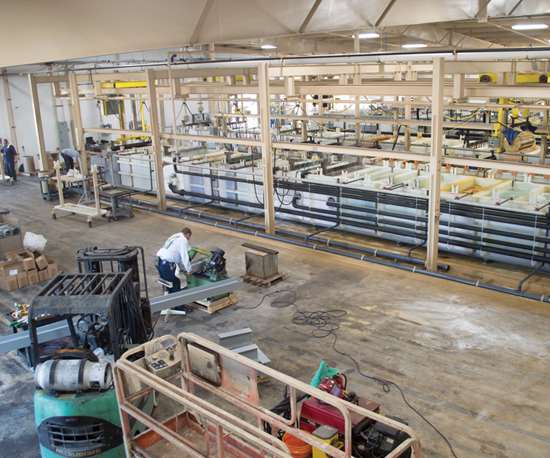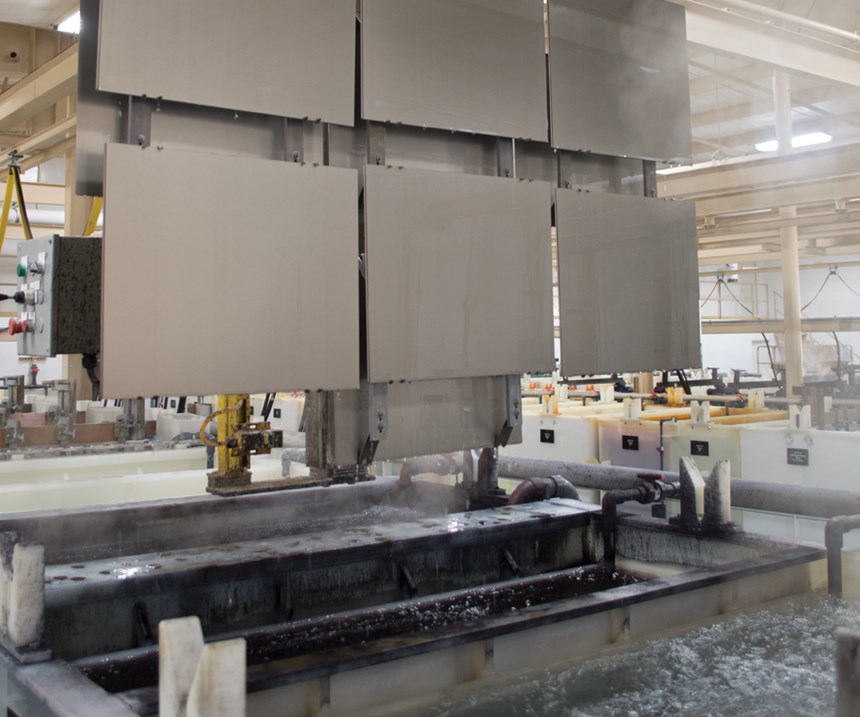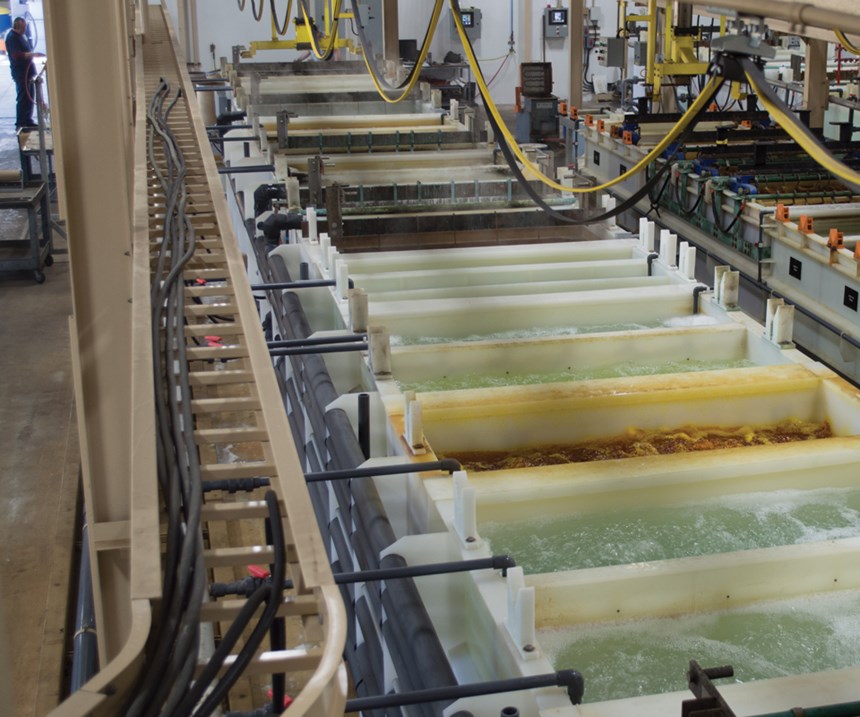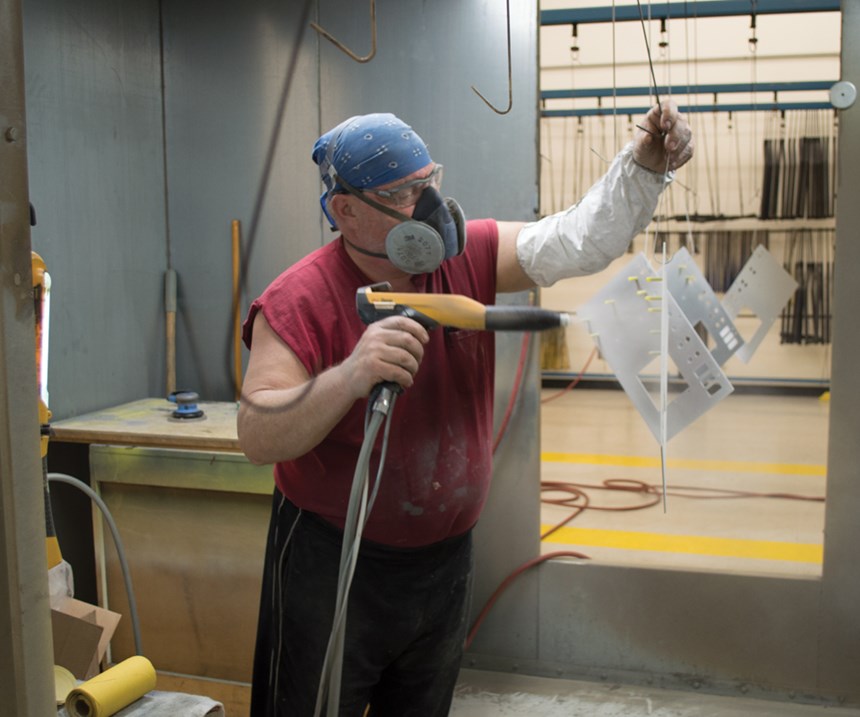Sun Glo Industrial Plating Survives Trial by Fire
Andy Pozin’s more than three decades in the metal finishing industry nearly came to an end in 2015 when an overnight fire devastated his company and his livelihood.
When Andy Pozin drove a delivery truck and made stops at local finishing shops throughout central Florida, he always noticed something unique about the plating shops on his route.
“The owners always drove nice cars and parked them right out front,” he says. “That caught my eye, and made me think that maybe I could be one of those guys.”
Featured Content
A few years later, Pozin became one of “those guys” when in 1986 he became the third owner of Sun Glo Industrial Plating in Clearwater, Florida, a Nadcap shop that offers anodizing, plating, conversion coatings, mechanical finishing and liquid and powder coatings.
More than 30 years later, Pozin doesn’t drive a fancy car—a nice pickup truck is his choice to go to and from the office—but he has become one of the most knowledgeable finishing owners in the Southeast part of the U.S., and one of the most entrepreneurial owners, to boot.
Pozin has grown what was once a three-person finishing operation to one with over 50 employees and extensive certifications and capabilities, including opening a machine and stamping operation next door in an adjacent building.
Sun Glo’s finishing menu includes Type I, II and III anodizing, silver and gold plating, cadmium and copper, electroless nickel, zinc phosphate and zinc rack/barrel plating, passivation, bright dip copper, tin plating, liquid and powder coatings, and mechanical finishing and harperizing, which Pozin says is a tumbling process that uses high-energy G forces to finish parts.
Devastating Fire
But despite the shop’s extensive capabilities, Pozin’s more than three decades in the metal finishing industry nearly came to an end in 2015 when an overnight fire devastated his company and his livelihood.
On a warm September night that year, a driver passing by Sun Glo’s facility at around 3:30 a.m. noticed smoke coming from the building and called 911. By the time the fire department arrived a few minutes later, flames had torn through one of the large buildings housing Sun Glo’s numerous plating lines.
When the dust settled, 19 plating lines went up in smoke, caused by a short circuit in a piece of equipment.
“It took out 40 percent of our entire finishing operation,” says Pozin, who happened to be on vacation with his wife in Italy when the fire occurred. He had to scuttle the trip and head back home to see how gutted his business was.
“Luckily, we had a manufacturing operation on the other side of the facility that kept us going, otherwise it would have been even more grim,” he says. “But it was brutal, to say the least.”
Not only did Pozin have to deal with the fire and the loss of business, but he then had to quickly figure out how to get things back up and running and keep the customers he had. It didn’t help that he was so far away when the destruction occurred, so he was delayed in calling customers to assure them their parts would still be finished in auxiliary lines in another building.
Pozin said there was no time to grieve at the near loss of his company, or to feel sorry for himself.
“I had 50 sets of eyes staring at me, wondering what my plan was going to be,” he says. “There were lots of questions from my employees; they wondered if I was even going to keep the company, or whether we would be out so long that they needed to get another job. There were a lot of people with concerns, and at the same time I am trying to come up with a plan of what to do next.”
Novice Plater
It wasn’t the first time Pozin stood alone wondering what to do. Going back 30 years ago, Pozin also had a similar experience when he first purchased Sun Glo and had little knowledge of running a plating facility. After leaving the Navy, he was driving a truck for an air freight company along with his father when they decided to start their own trucking company.
“My father and I were getting 60 percent of the fee for the freight company we were working for,” Pozin says. “We decided to keep 100 percent of it and find our own businesses to deliver for.”
Most of his customers were platers, heat treaters and screw machine companies, which have a lot of weight that needed to be picked up and shipped throughout central Florida. He and his father expanded the business several times, but Pozin kept noticing all the nice cars the owners of the plating shops drove whenever he visited their facilities.
“I was 25 and very impressionable,” he says. “I started talking to the owner of Sun Glo, and he was telling me about how the new requirements for waste treatment were coming in for plating shops, and he really wanted no part of that. So we spoke a few times, and that’s when I decided to buy it.”
Pozin says he struggled early getting to know the business model, and the former owner may have made the deal thinking that Pozin might default on his loan and he could take back the shop.
“It never happened,” he says. “I worked my tail off to get things going, and looking for ways to grow the business. Unlike up north where you can run barrel plating and make a killing, down here in Florida we had to be a jack-of-all-trades and really perform a lot of operations.”
In the Navy, Pozin was a nuclear machinist on one of the nuclear subs, and spent two years in training learning about heat transfers, pumps and other intricacies of the operation, plus he attended a vocational high school and spent three years studying industrial electricity.
Growing Customer Base
All of that gave him a good base knowledge of what needed to be done in a plating operation, and—with a work ethic second to none—Pozin grew Sun Glo and its customer base.
“Between high school and everything they threw at me in the Navy, I was pretty much taught everything I needed to know about running a plating shop,” he says. “They had a nickel chrome and galvanizing line, plus some zinc when I took it over. We had two guys here and me. That was my starting point.”
Pozin has grown the company steadily, and at one point had over 100 employees working for him. He added Nadcap certifications to almost all of his plating lines, and partnered with several aerospace firms to perform its coating operations, including General Electric, Lockheed Martin and others.
A few years ago, Pozin made a strategic move with a Fortune 300 manufacturing customer they were servicing and opened a metalworking shop next door to machine and stamp their parts before finishing them, and then warehoused the parts and shipped them to their customer as part of a fulfillment agreement.
“It was basically a vendor-maintained inventory partnership,” he says. “We made their parts, finished them and then shipped their parts; we were in charge of the entire supply chain for them.”
Things were going well for Pozin and Sun Glo—they even received a $5,000 prize in Fifth Third Bank’s Curious Customer contest that honored achievements by small businesses—until the morning of Sept. 18, 2015, when the fire struck. For 45 days, the insurance company wouldn’t even let them enter the shop to start rebuilding, causing further annoyance.
Self-Contained Electrical Area
“I’ve always prided myself on the maintenance of my shop, so when we had to design a new plant, I knew I didn’t want our guys to have to stand on their heads when they were working on a pump or something,” he says.
The first thing he did was powder coat everything—every electrical conduit, every junction box, every breaker box. The goal was to protect metal from rusting in what could be a very caustic environment of a plating shop.
The Sun Glo crew did most of the rebuild themselves, including removing the debris from the fire and then building walls, adding insulation and installing lights.
“If guys weren’t running the plating lines we had left to help generate revenue to keep us going, then they were swinging hammers or had a welder in their hand rebuilding,” he says.
One of the most interesting aspects of his shop’s rebuild was to partner with American Plating Power in nearby Fort Myers to design an area that kept rectifiers, control cabinets, heat exchangers and pumps in a separate room on the end of the facility, and away from the plating area where corrosion might attack those important components of the operation.
Rebuild Means New Start
“Nothing is on the plating shop floor where it is open to those elements,” Pozin says. “We built a conditioned area and set all the components up very nicely so that they can run very efficiently and be easily maintained.”
Waasy Boddison, owner of American Plating Power, says it is one of the best setups of a plating operation he has ever seen.
“Andy had a great idea of how he wanted all the rectifiers and equipment set up, and it’s pretty ingenious,” Boddison says. “He’s a smart guy, but also a really great guy. We wanted to help him get his shop back up as quickly as we could, but the way he designed it is a very good way to go.”
Pozin also replaced all the PVC conduits in the facility with steel; he remembered when he entered the facility after the fire and seeing all the plastic piping hanging down from the rafters like ropes.
“We actually have very few electrical pipes in the process area at all,” he says. “We installed a big bus duct that runs inside the room to the control cabinets, and then into the rectifiers and to the pumps and solenoid valve, and all at one end of the shop. There is no electrical run that is over 15 feet.”
The only electrical components on the shop floor are the touchscreen heads at the end of each plating line, which are all low voltage. Pozin also designed the system so that on top of every touchscreen is a red light that the illuminates when all of the power to the head is completely off.
“I can look down the line at all the heads and see all the red lights on, which tells me that everything electric in that plating area is off,” he says. “It lets me know I will not burn anything down because I left it on. There is nothing better than a visual confirmation.”
For information on Sun Glo Industrial Plating, visit sun-glo.com; for information on American Plating Power, visit americanplatingpower.com.
Originally published in the June 2017 issue.
RELATED CONTENT
-
Choosing and Troubleshooting Copper Electroplating Processes
Learn more on this inexpensive and highly efficient process.
-
A Chromium Plating Overview
An overview of decorative and hard chromium electroplating processes.
-
Plating Q&A: Can you color stainless steel?
Our expert, Art Kushner, says yes, you can color stainless steel, but it is not a process that is typically performed in a plating shop. Read more about his answer.
























